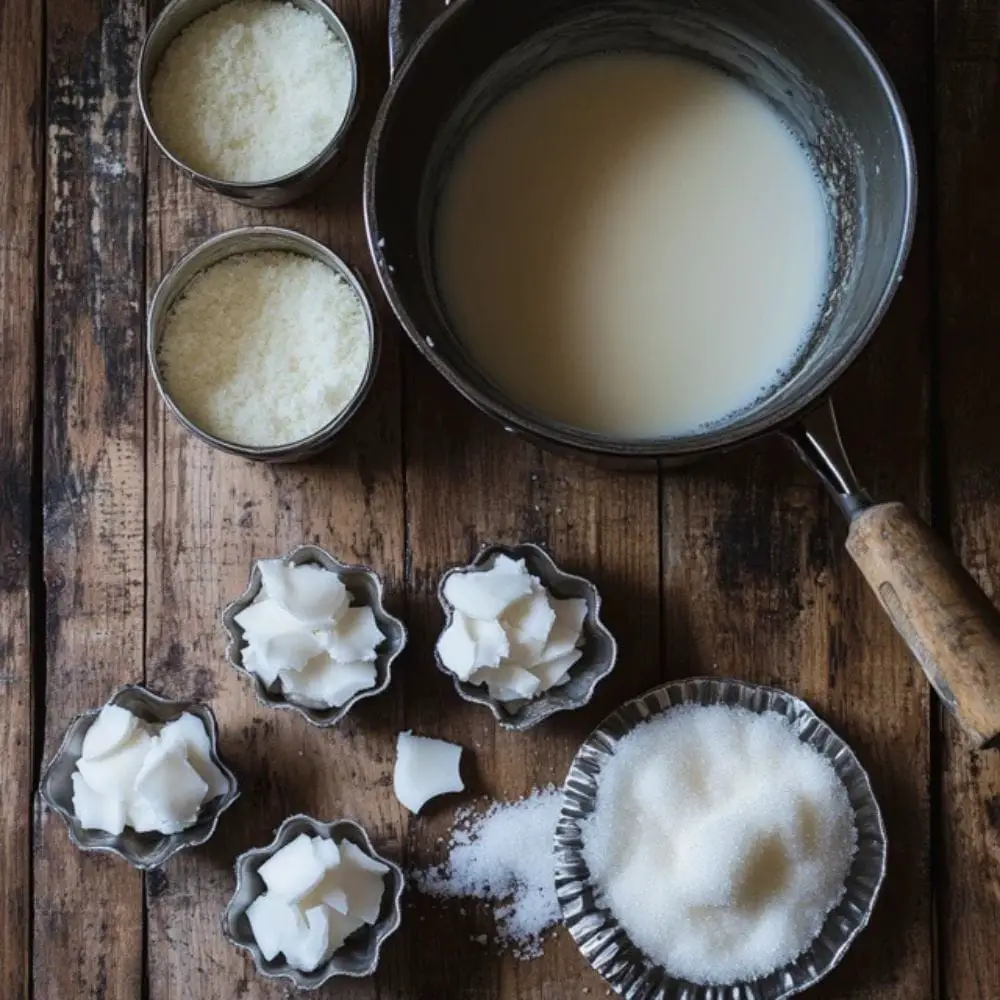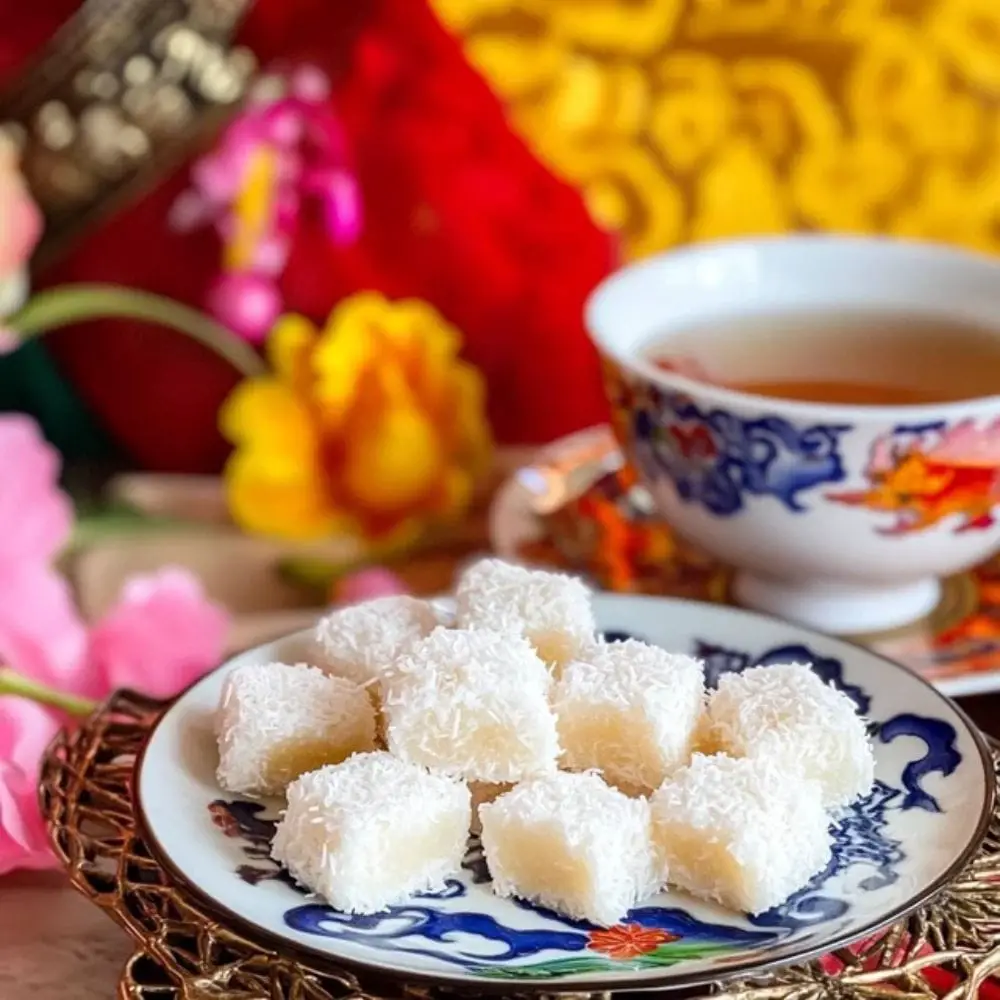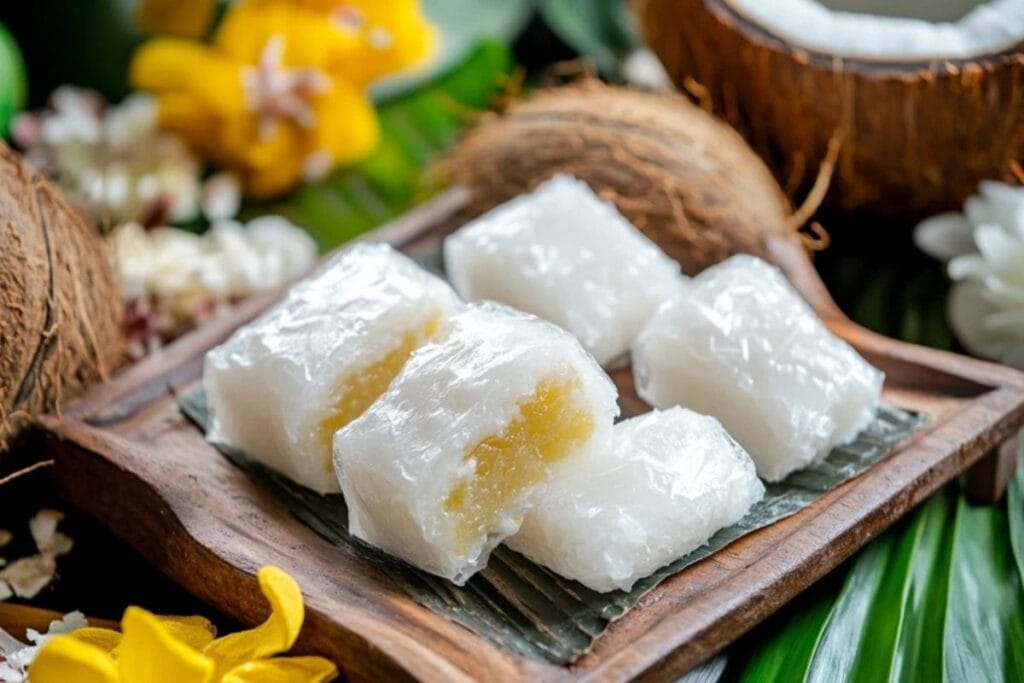Vietnamese coconut candy is a sweet treat from Bến Tre province. It is known locally as kẹo dừa. Families often share these chewy squares during festive times. They also make them for visitors, showing off a warm Southern welcome. This candy uses simple ingredients yet carries tradition in each bite. Folks say it brings happiness.
Many call Vietnamese coconut candy a star of traditional Vietnamese sweets. And it holds a proud place in local markets. The candy has coconut milk and sugar boiled until thick. Now, people try new flavors too. Yet the heart of this candy remains coconut. Its taste reminds many of home and family.
Traditional Ingredients in Vietnamese Coconut Candy
Coconut Components in Traditional Vietnamese Coconut Candy
Fresh, high-quality coconuts are the foundation of authentic Vietnamese coconut candy. Locals in Bến Tre province, where the candy is famous, carefully select high-oil coconut varieties known for their rich flavor and creamy texture.
- Grated coconut flesh – Extracted to produce coconut milk and cream, which forms the candy’s base.
- Pressed multiple times – Ensures maximum extraction, creating the smooth, creamy consistency that people love.
- Shredded coconut pulp – Sometimes blended back into the mixture for extra texture and richness.
- Coconut oil content matters – Wetter coconuts create a smoother candy, while drier coconuts result in firmer, chewier squares.
The freshness and quality of the coconut directly influence the final candy’s texture, taste, and aroma. The best coconut candy boasts a silky-smooth consistency with a lingering tropical scent.
Sweetening Agents
To achieve the perfect balance of sweetness and chewiness, candy makers rely on a mix of sugar and malt syrup:
- Sugar – Provides the fundamental sweetness, dissolving slowly in the coconut milk as it heats.
- Malt syrup – Adds a mild caramel note and a chewy texture, preventing the candy from being overly brittle.
- Slow cooking – Ensures that the sugars develop properly without burning, creating the signature sticky consistency.
- Balancing color and flavor –
- More malt syrup results in a deeper caramelized hue and richer taste.
- Less malt syrup or pure sugar versions create a lighter, delicate coconut candy.
Many traditional artisans prefer a subtle malt edge, giving the candy depth and a lingering sweetness that melts on the tongue.
Additional Flavorings
While pure coconut flavor remains the heart of this confection, regional variations introduce natural ingredients to enhance aroma and taste:
- Pandan leaves – A popular addition that infuses the candy with a light, floral fragrance that pairs beautifully with coconut.
- Durian – A bold, pungent twist for adventurous eaters who appreciate its unique aroma.
- Taro – Adds a mild, earthy sweetness that blends smoothly into the coconut base.
- Cocoa powder – Provides a subtle chocolate contrast, making for a slightly richer, more indulgent version.
- Pinch of salt – A small but crucial touch that heightens the sweetness and enhances overall flavor complexity.
Artisans take great care in balancing flavors, ensuring that additional ingredients enhance rather than overpower the natural richness of the coconut. This delicate balance is what makes traditional Vietnamese coconut candy both simple and sophisticated in taste.
The Manufacturing Process of Vietnamese Coconut Candy

Extraction of Coconut Milk for Vietnamese Coconut Candy Composition
The process begins with the extraction of fresh coconut milk, which is the core ingredient of Vietnamese coconut candy.
- Shredded coconut is placed into a cloth bag and pressed multiple times to release the thick, creamy liquid.
- Hand-pressed methods yield a richer consistency, but factories often use machines for efficiency.
- Nothing goes to waste – the remaining coconut pulp is often used for animal feed or secondary coconut-based products.
- Fresh coconut milk must be used immediately, as it can turn sour if left too long, affecting the final candy’s flavor.
The timing and quality of the coconut milk extraction are crucial for ensuring a clean, tropical aroma in every batch of candy.
Cooking the Mixture
Once the coconut milk is extracted, it is combined with sugar and malt syrup in large cooking pots to create the candy base.
- The mixture is stirred continuously to prevent burning and ensure even thickening.
- The cooking process starts at a low temperature, then gradually increases to bring the mixture to a gentle boil.
- Too much heat can scorch the mixture, while too little heat results in a weak consistency.
- Skilled candy-makers observe texture changes carefully, waiting until the mixture thickens into a glossy, toffee-like paste.
Once the ideal consistency is reached, the candy is quickly removed from the fire and left to cool. This critical step requires precision to achieve the perfect chewy texture.
Molding, Cutting, and Wrapping Traditional Vietnamese Coconut Candy
After cooking, the hot coconut mixture is poured onto flat trays lined with parchment paper for setting.
- Once firm, the candy is cut into small rectangular or square pieces, marking the formation of traditional Vietnamese coconut candy.
- While still warm, the candy remains pliable and can be shaped as needed.
Wrapping Methods:
- Edible rice paper – Many traditional makers wrap each piece in thin, edible rice paper, preventing stickiness and preserving texture.
- Modern packaging – Some producers now use plastic or foil wrappers for commercial distribution, but many still favor the old ways.
- Rice paper benefits – This delicate, melt-in-your-mouth layer enhances the smooth, chewy experience of Vietnamese coconut candy.
By maintaining time-honored techniques, coconut candy retains its cultural significance, offering an authentic taste of Vietnamese tradition and craftsmanship.
Variations and Flavors in Kẹo Dừa
Classic Candy Using Vietnamese Coconut Candy Ingredients
Basic kẹo dừa blends coconut milk, sugar, and malt syrup. These Vietnamese coconut candy ingredients remain the foundation. Cooks rely on fresh coconut for that mild sweetness. People say the classic version needs no extra twist. It stands firm as a symbol of Bến Tre province pride.
Some call this the original taste, linking heritage and daily life. They keep the recipe simple. Yet each batch has a small difference, based on the coconuts’ ripeness. Now and then, folks argue over brand loyalty. But everyone agrees the classic has heart and soul.
Old family recipes often pass down through generations, preserving the candy’s timeless flavor.
Flavored Variations
Modern tastes crave variety. Durian-laced kẹo dừa appeals to adventurous eaters. Others seek pandan for a bright green hue. So taro offers a subtle purple color and earthy tone. Vendors roll out coconut candy variations that entice tourists. They also play with cocoa or green tea for new tastes.
People like to sample these colorful options at local markets. Yet the coconut undertone remains. Different flavors of kẹo dừa can show off imaginative spins on tradition. Those curious to learn more check different flavors of kẹo dừa for a deeper look at how each version stands apart.
Regional Differences
Some provinces add roasted peanuts to create a crunchy edge. Others mix black sesame seeds for a nutty finish. Also a few tweak the sugar ratio for a milder candy. Certain places hold local fairs where they demonstrate their own style. Though Bến Tre leads production, each region claims a special spin.
Folks might argue which type tastes best. But that’s part of the fun. Every place has a story behind its version. Tourists enjoy sampling each style while traveling. Now, these small differences keep the candy exciting and unique. They reflect the spirit of local communities.
Nutritional Insights on Coconut Sweets
Caloric Content
Each small square can hold a moderate amount of calories. People estimate around 40 to 50 calories per piece. But that can change if extra sugar or cream is used. So those watching their diet may keep portions small. Many see it as an occasional sweet rather than an everyday snack.
Friends might share a few squares over tea. That way, the calories spread across the group. Still, coconut cream brings healthy fats. Some say these medium-chain fats may offer quick energy. Ultimately, moderation stays key for balanced enjoyment. The candy remains a treat worth savoring.
Macronutrient Breakdown of Traditional Vietnamese Coconut Candy
Traditional Vietnamese coconut candy blends carbohydrates, fats, and minimal protein. Sugar and malt syrup offer carbs. Meanwhile, coconut cream has fats that give richness. The protein content is lower. But each bite is more about taste than bulk nutrition. And the ratio shifts if recipes change.
Local dietitians often mention the sugar content when asked about candy intake. They say mindful consumption keeps blood sugar in check. Still, coconut candy might be a better choice than some heavily processed desserts. Folks can decide what works best for them, given personal health goals.
A small indulgence can be part of a balanced lifestyle when eaten sensibly.
Health Considerations
Those concerned about sugar might want to enjoy smaller servings. Coconut candy can spike glucose if eaten too freely. Yet some believe the coconut fats help slow absorption. Still, people with health conditions must use caution. And it’s smart to check ingredient labels for any additives.
Parents often limit their children’s intake. But they still let them enjoy a piece or two during holidays. Many find that balance keeps everyone happy. Some folks prefer homemade versions with less sugar. This helps them manage sweet cravings without going overboard.
Serving Suggestions and Pairings

Beautifully Presented Vietnamese Coconut Candy
Kẹo dừa, or Vietnamese coconut candy, is more than just a sweet treat—it’s a symbol of tradition and hospitality. When served on a decorative plate alongside a steaming cup of tea, it evokes the warmth of family gatherings and festive celebrations. During Lunar New Year (Tet), beautifully wrapped coconut candy is displayed with other delicacies, creating a vibrant and welcoming atmosphere.
Occasions for Enjoyment
Vietnamese coconut candy holds a special place in cultural traditions and social gatherings:
- Tet (Lunar New Year) Celebrations – Families share trays of coconut candy while exchanging wishes for prosperity and happiness.
- Gift for Guests – Offering kẹo dừa to visitors is a gesture of goodwill and hospitality.
- Reunions & Visits – Locals often bring these sweets as a symbol of harmony and togetherness when visiting relatives.
- Community Events & Weddings – Often featured alongside other traditional Vietnamese sweets, adding to the festive mood.
Sharing coconut candy during festivals and gatherings strengthens family bonds and cultural pride, making it more than just a dessert—it’s a tradition that connects generations.
Beverage Pairings
The sweet, creamy richness of coconut candy pairs well with bitter or refreshing drinks that balance its flavor:
- Hot green tea – A classic pairing that cuts through the sweetness with a mild bitterness.
- Iced Vietnamese coffee – The bold, slightly bitter coffee contrasts beautifully with the creamy candy.
- Fruit teas (hibiscus, passionfruit, or lemon) – Refreshing options that cleanse the palate.
- Mild beer or light wine – Adds a fun twist, though balancing sugar levels is key.
A sip of tea or coffee between bites ensures that each piece of coconut candy remains fresh and satisfying without overwhelming the taste buds.
Incorporating into Desserts
Beyond being eaten on its own, kẹo dừa enhances a variety of desserts by adding crunch, chewiness, and rich coconut flavor.
- Ice cream topping – Crushed coconut candy adds a satisfying crunch to vanilla, chocolate, or tropical-flavored ice cream.
- Cake drizzle – Melted candy creates a caramel-like coconut glaze over cakes or pastries.
- Brownies and cookies – Chopped candy pieces introduce chewy coconut pockets into baked goods.
- Custards and puddings – Shavings of kẹo dừa swirled into creamy desserts create delightful bursts of flavor.
Families love trading baking tips featuring coconut candy, ensuring every gathering has a special homemade treat.
Storage and Shelf Life
Proper Storage for Vietnamese Coconut Candy
To maintain freshness, coconut candy should be stored in cool, dry conditions:
- Airtight containers – Prevents moisture from softening the candy.
- Away from sunlight and heat – Protects texture and prevents melting.
- Refrigeration – Optional, but it may firm up the candy too much.
Since coconut candy absorbs odors easily, keeping it in a sealed glass jar or vacuum-sealed bag ensures its natural sweetness remains intact.
Shelf Life Expectations
Properly stored, kẹo dừa can last several weeks:
- Commercially packaged candy – Best consumed before the printed expiration date.
- Homemade versions – Fresh for about a month if stored well, but flavor may fade over time.
- Signs of spoilage – Discoloration, a rancid coconut smell, or a stale taste indicate it’s best to discard the candy.
To fully enjoy its rich, creamy taste, coconut candy is best consumed while still fresh.
Packaging for Gifting
Beautiful Wrapping for Special Occasions
Vietnamese coconut candy is often individually wrapped in colorful foil or presented in decorative boxes, making it a popular gift choice:
- Bright wrappers and festive designs – Enhance the candy’s appeal as a Tet gift or souvenir.
- Ready-packed gift sets – Often feature local Vietnamese motifs, making them ideal for travelers.
- Perfect travel gift – Stays fresh in stable temperatures, making it easy to carry abroad.
Tourists and locals alike love gifting coconut candy, as it represents the warmth and hospitality of Vietnamese culture in a delightful, edible form.
Economic and Cultural Significance
Role in Local Economy
Coconut candy production supports families in Bến Tre province. This region thrives on coconut farming. So many locals earn a living from harvesting and candy-making. Factories buy coconuts from small farms, creating a steady market. And some businesses export the candy abroad.
Farmers benefit because their sales are consistent. Their coconut groves also attract tourists who love seeing how kẹo dừa is made. This synergy feeds the local economy. People are proud that their traditional Vietnamese sweets reach international shelves. It shows how a simple treat can power a community.
Most families involved in candy-making rely on coconut groves that have been tended for generations.
Cultural Symbolism
Sweetness reflects harmony, and folks see this candy as a small taste of comfort. Furthermore, weddings often feature coconut candy to symbolize unity, as it’s believed that sharing sweetness builds bonds. Additionally, the bright wrappers bring a festive feel, and many older folks recall childhood memories where candy brightened tough days.
Some families keep a jar on the kitchen table because they say it warms the home atmosphere. Additionally, visitors often receive coconut candy with tea, which is a gracious gesture that fosters friendships. Moreover, these traditions pass from one generation to the next, keeping the spirit alive.
Tourism and Coconut Candy
Bến Tre offers tours to show how kẹo dừa is made. Visitors watch each step: pressing coconut, cooking, then cutting squares. The region’s workshops have become popular stops for travelers seeking authentic experiences. Some even try stirring the hot mixture, guided by local experts.
People leave with fresh coconut candy in hand. Kids enjoy nibbling samples right off the cutting table. Some places highlight the production process of Vietnamese coconut candy to illustrate the candy’s deep roots. Tourists carry stories of flavor and tradition back home. It fosters awareness of this sweet heritage.
Common Misconceptions
Ingredients Used in Vietnamese Coconut Candy Recipes
Rumors arise that mass producers add artificial fillers. Yet many brands stick to simple coconut milk, sugar, and malt syrup. They avoid extra chemicals that alter flavor. Sometimes, folks assume coloring is always synthetic. But natural hues can come from pandan or cocoa powder. And those do not harm authenticity.
Small shops preserve the age-old formula. They want to keep the candy pure and mild. Also, local producers emphasize fresh coconuts. They say it boosts taste more than any artificial agent. The idea that coconut candy is full of preservatives may not hold true when buying from trusted sellers.
Production Methods
Some believe every batch is machine-made now. That’s untrue for many cottage industries. Home-based setups still thrive in the countryside. Workers stir pots by hand. They watch the candy shift from liquid to thick fudge. Then they cut squares with simple tools. Machines help in larger factories, but artistry remains.
Old-fashioned techniques pass down through apprenticeships. People see that tradition endures. And modern processes often replicate those steps on a bigger scale. They keep the original spirit while meeting higher demand. Candy fans appreciate both methods. Each approach respects the candy’s origins in different ways.
Health Implications
Some claim coconut candy is too unhealthy to eat. But it all depends on moderation. Sugar is a key ingredient, so portion control matters. Still, coconut’s natural fats may offer some benefits compared to hydrogenated oils. It is not a health food, though it’s also not the worst indulgence.
Dietitians suggest pairing with a balanced diet. They remind folks to watch their sugar intake overall. Now, occasional enjoyment won’t ruin anyone’s wellness routine. People find that these sweets can fit into a mindful lifestyle. As always, personal health goals drive decisions about candy consumption.
FAQs About Vietnamese Coconut Candy
What is the origin of Vietnamese coconut candy?Are there different flavors of Vietnamese coconut candy?How is Vietnamese coconut candy made?What makes Bến Tre coconut candy unique?Is Vietnamese coconut candy vegan?
Final Thoughts
Vietnamese coconut candy stands as a cherished gift of flavor and tradition. It reminds many of gentle breezes over coconut groves and joyful celebrations. Each piece delivers a sweet memory of Southern Vietnam’s warmth. People enjoy sharing it, gifting it, and adding new twists.
Some days, a small square can brighten a moment. It’s more than candy. It’s a symbol of heritage. And it continues to bring folks together. Whether you prefer the classic or a new flavor, kẹo dừa invites you to taste a bit of local pride. The result is pure, simple delight.






